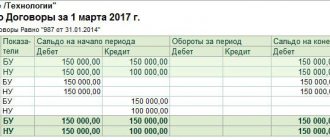Account 60 is used in the accounting of an organization to reflect information about settlements made with suppliers and contractors for goods and materials received, as well as work performed and services rendered, their surpluses, transportation services received, and others.
The account is credited for the cost of goods accepted for accounting (work performed, services provided) and corresponds with the accounts for their accounting. In synthetic accounting, the account is credited on the basis of the supplier's settlement documents, regardless of the assessment of values in analytical accounting.
The account is debited for the amounts of fulfillment of obligations, including advances and prepayments (they are accounted for separately) and corresponds with the accounts in which funds are recorded.
Subaccounts 60 accounts
Analytical accounting for accounting account 60 is carried out separately, in the context of each presented invoice. At the same time, it is necessary to organize this accounting in such a way as to ensure the receipt of the necessary information on suppliers for settlement documents that have not yet become due for payment, for suppliers for settlement documents that have not yet been paid on time, for suppliers for bills of exchange issued that have not yet become due for payment, by suppliers according to the loan received and others.
Among the subaccounts in accounting on account 60, the following are usually distinguished:
- 60.01 - Settlements with suppliers and contractors - serves directly to reflect mutual settlements with creditors;
- 60.02 - Calculations for advances issued - it reflects advance payments to suppliers;
- 60.03 - Bills of exchange issued - a special sub-account for recording securities;
As well as accounts for accounting for mutual settlements in monetary units. and currency:
- 60.21 - Settlements with suppliers and contractors (in foreign currency) - analogous to 60.01 for currency accounting;
- 60.22 - Calculations for advances issued (in foreign currency) - analogous to 60.02 for currency accounting;
- 60.31 - Settlements with suppliers and contractors (in conventional units) - analogous to 60.01 for settlements in conventional units;
- 60.32 - Calculations for advances issued (in conventional units) - analogous to 60.02 for calculations in conventional units.
Accounting
Maintaining accounting records for an enterprise involves registering and processing contractual documentation for the supply of materials, raw materials, related goods and services. When the company receives materials, depending on the terms of the contract, a receivable may arise if deliveries were made on the terms of payment upon receipt or partial prepayment. Debt obligations are recorded in the reporting documentation for subsequent payments by the company to the contractor.
To generate financial statements, primary documentation is used, including:
- invoices for goods
- waybills
- acts of acceptance of goods, materials, raw materials
- certificates of work performed, services provided
- tax invoices
- Bank statements
All primary documentation is necessary for calculating the cost of goods and services, for subsequent mutual settlements, payment of taxes and other payments. As a means of accounting for debt obligations and other settlements, account 63 “Settlements with suppliers and contractors” is used, where information obtained from primary documentation is entered with reference to other financial entries. Account 63 has sub-accounts designed for settlements with domestic suppliers, foreign counterparties, and international industrial and financial groups.
Debt to suppliers for materials is calculated when maintaining company accounting in various currencies, including national or foreign. Final payments, subject to recording in tax reporting, are made in national currency with the possibility of conversion upon transfer of money to personal accounts.
Maintaining accounting for debts to suppliers for materials and raw materials allows you to record complex debt obligations and individual entries for each completed contract or delivery item.
Top
Write your question in the form below
Example of a balance sheet for account 60
Let's give an example of a balance sheet for account 60 from the popular 1C program with full detail on sub-accounts and analytics:
For example, from the SALT it is clear that over the past year we paid the counterparty “Supplier LLC” 13,681 rubles, and received goods or services in the amount of 154,727 rubles. And the total debt on the final balance of the loan is 141,046, that is, our debt.
Account 62 in accounting
receivable is a type of asset defined as the amount of debt of legal entities or individuals of an organization that arises from the sale of products on credit.
In accounting, accounts receivable are understood as property rights and, therefore, accounts receivable are classified as property of the organization. Accounting for accounts receivable is necessary to control the debts of counterparties and their timely collection. Excessive growth of accounts receivable can lead to a loss of financial stability of the organization, since often accounts receivable are used to pay off accounts payable. In practice, to speed up payments by counterparties for shipped goods, various systems of discounts and incentives are used. For example, a 10% discount for prepayment of goods.
Basic accounting entries for account 60 with subaccounts
By debit of the account:
| Account Dt | Kt account | Contents of operation |
| 60 | 50.01 | Repayment of debt to the supplier from the cash register |
| 60 | Repayment of debt to the supplier in non-cash form | |
| 60 | Repayment of debt to the supplier in foreign currency | |
| 60 | 55.01 | Write-off of the amount of the used letter of credit for settlements with the supplier |
| 60 | The offset of counter homogeneous claims is reflected | |
| 60 | 66 | Re-registration of a debt to a supplier into a short-term loan |
| 60 | 67 | Re-registration of a debt to a supplier into a long-term loan |
| 60 | 76.02 | Withholding the amount of an admitted claim from funds payable to the supplier |
| 60 | 91.01 | Outstanding accounts payable included in other income due to the expiration of the statute of limitations |
| 60 | 91.01 | Positive exchange rate difference on receivables in foreign currency included in other income |
By account credit:
| Account Dt | Kt account | Contents of operation |
| 60 | Equipment requiring installation has been registered | |
| 08 | 60 | Supplier invoices accepted for payment for acquired non-current assets |
| 10 | 60 | Materials received from suppliers were capitalized |
| 15 | 60 | The purchase price of inventories for which settlement documents were not received from suppliers was taken into account |
| 15 | 60 | Costs associated with stockpiling are taken into account |
| 19 | 60 | VAT on capitalized assets |
| 20 | 60 | The cost of work (services) performed by contractors is taken into account in costs. |
| 60 | General production expenses include the cost of work (services) performed by contractors. | |
| 60 | The cost of work (services) performed by contractors is taken into account as part of general business expenses. | |
| 60 | The cost of contractors’ work is included in the cost of eliminating defects | |
| 41 | 60 | Goods received from suppliers were capitalized |
| 44 | 60 | Inclusion in expenses of the cost of work and services related to the sales process |
| 50 | 60 | Return by the supplier of the excess money paid to him to the organization's cash desk |
| 60 | Return by the supplier of excess funds paid to him to the organization's bank account | |
| 60 | Return by the supplier of excess funds paid to him to the organization’s foreign currency account | |
| 76.02 | 60 | The amount of the claim against the supplier is reflected |
| 91.02 | 60 | Accepted for payment invoices from other organizations for services related to the disposal of other assets |
| 91.02 | 60 | Write-off of accounts receivable that are unrealistic for collection (no reserve was created) |
| 91.02 | 60 | Reflection of negative exchange rate difference on accounts payable in foreign currency |
| 60 | Reflection of shortages upon acceptance of valuables received from the supplier | |
| 97 | 60 | Reflection of debt to suppliers for work performed, for which costs are charged to deferred expenses |
Payments to suppliers: postings and reflection on accounts
In the bay. In accounting documents, this position is reflected in account No. 60. When compiling the organization’s balance sheet, this indicator is necessarily reflected. By its structure, it is both a passive and an active account. It includes both debit receipts (advances and prepayments) and credit funds.
Entries in it are made on the basis of documents sent by the supplier:
- packing list;
- certificate of work done;
- invoice, etc.
The type of posting depends on the type of calculation performed
It is important to display all the numbers that are deposited into the account on time. This must be done regardless of any events. All amounts are indicated in accordance with the available settlement documentation.
All debts are written off according to the conditions specified in PBU No. 34. The maximum limitation period is 3 years. In parallel with the sixtieth account, you can control monetary and material transactions with counterparties in reporting journal No. 6. It includes analytical and synthetic types of accounting.
Transfer of advance payment
If the prepayment to the supplier is transferred in advance, then on account 60 the column “advance issued” should be filled in. When the money has arrived to the addressee, you need to post D60 K60.
All financial transactions and amounts must be reflected in the documentation in a timely manner so that no problems arise.
Covering debt in cash
When performing this kind of transaction, the following posting should be made: D 60 K 50. In this case, the following subaccounts can be used for account No. 50:
- from the main cash register of the organization;
- from commodity checkouts;
- bills, other financial documents.
In addition to the accounts and balance sheet, all money transfers made must additionally be entered into the cash book. This is done on the basis of a cash receipt order.
From personal account
If payment is made by bank transfer, then posting D60 K51 is carried out. This is done and recorded in 51 accounts. The company can create a separate column for each counterparty. The basis in this case is a bank statement, receipt or other supporting document.
When debts arise, it is important to agree on a peaceful solution to the problem
Despite the fact that different types of repayment of incurred accounts payable are recorded in different accounts, the link for all of them is No. 60, where the final indicators are entered. It is in accordance with it that all operations are carried out.
You always need to know how much has been transferred from your current account to repay debts to suppliers for materials, goods and services. It is necessary to track these numbers, since the slightest discrepancy can subsequently lead to quite large losses.
If the letter of credit has been received and the money has reached the addressee, the debt is considered fully repaid. In the case where a loan is being paid in installments, payment documents must be retained after each transfer of money, and transaction data must be displayed in the appropriate sections of the balance sheet.
Accounting for accounts receivable
After determining the structure of a business transaction, creating a posting will not be difficult even for a novice accountant. Below you can clearly study examples of postings for basic business transactions.
Suppliers are enterprises that supply inventory (raw materials, materials, fuel, building materials, spare parts, small items), as well as provide services (supply of electricity, gas, water, etc.) and perform other work necessary for the enterprise, organization for carrying out production activities. Open analytical accounts for account 60 “Settlements with suppliers and contractors”, make the necessary entries in them.
If your company has shipped goods and products to the buyer, then after the ownership of them has transferred to the buyer, make a posting Debit 62 Credit 90-1 to take into account the buyer's debt for the goods shipped.
And only after three years from the date the decision entered into legal force can the debt be considered hopeless (Letter of the Ministry of Finance of Russia dated September 21, 2007 N 03-03-06/2/184).
At 13, a girl dreams of a prince, at 20, a businessman, at 30, if only she didn’t drink, at 45, if only she didn’t leave. Why are the requirements being reduced?
Compile turnover sheets for analytical accounts for subaccount 10-5. Check the results of the turnover sheets with the results of the corresponding synthetic accounts.
At 13, a girl dreams of a prince, at 20, a businessman, at 30, if only she didn’t drink, at 45, if only she didn’t leave. Why are the requirements being reduced?
Compile turnover sheets for analytical accounts for subaccount 10-5. Check the results of the turnover sheets with the results of the corresponding synthetic accounts.
At the same time, KZ is taken into account as non-operating income, except for debt to government agencies and extra-budgetary funds (Article 250 of the Tax Code of the Russian Federation, clause 18; Article 251, clause 21), DZ is included in non-operating expenses or is included in the account. 63 “Provisions for doubtful debts”.
The group is a holding company consisting of specialized companies operating in the field of consulting services, providing business development and support. The group has been operating in the legal services market since 1999 and during this time it has taken and confidently holds the position of one of the largest legal agencies in the Sverdlovsk region.
The additional one includes various payments, such as housing and communal services. In rare cases, housing and communal services fees are included in the general rent.
Due to physical wear and tear, the machine is liquidated: a) the amount of previously accrued depreciation D02 K01 is written off b) the residual value D91 K01 is written off c) materials from the liquidation of the machine D10 K91 are credited to the warehouse d) wages D91 K70 are accrued to the workers for dismantling the equipment e) social insurance contributions (34% of the salary) ???
VAT and Income Tax depends on the methods of generating income!! !1) by assigning the acquired right of claim at a higher price; 2) when repaying the debt by the debtor if it was acquired at a lower price. The procedure for paying VAT when assigning the right of claim to a third party is prescribed in clause 4 of Art.
When the organization has transferred the goods, accordingly, the ownership right is also with the buyer, which means that the resulting debt needs to be reflected in accounting. For example, the entry may look like this: Debit 62 Credit 90-1 – reflection of the debt for goods received; Or: Debit 62 Credit 91-1 – indicate sales revenue. For budgetary and autonomous institutions that receive subsidies, regardless of whether funds from the previous financial year or the current one are credited, this operation is considered as a restoration of cash expenditures and the funds received are not transferred to budget revenues. It should be borne in mind that these funds must be used for the same purposes for which they were initially allocated.
Most often, errors occur when recording transactions on uninvoiced deliveries and inventories in transit in the accounting accounts.
The entire amount of debt of buyers for goods shipped to the principal without prepayment, reflected in the debit of account 62, is not1 under the article Goods shipped in the balance sheet of the organization, the cost of goods shipped is reflected in the case if ...
Payment of accounts receivable posting
The reasons for the occurrence of accounts receivable can be explained by the following premises. The creditor organization receives additional sources of sales for its products, while the creditor, by shifting the loan repayment date, receives additional cash and current assets.
We present typical entries for accounting for accounts receivable in our material. Accounts receivable: accounting accounts In accordance with Section VI “Calculations” of the Chart of Accounts and Instructions for its application (Order of the Ministry of Finance dated October 31, 2000 No. 94n), synthetic and analytical accounting of the organization’s receivables is maintained on the following accounts:
Accounting entries for accounting transactions on a foreign currency account
As stated above, when writing off debt, its amounts are simultaneously taken into account in off-balance sheet accounts 04, 20.
In practice, there are situations when, if there are insufficient funds to fully repay the receivables, the debtor (usually the buyer) transfers his own bill of exchange to the organization.
Received to the current account from debtors in repayment of debt D51 K76 3. Accepted invoice from suppliers for materials received from them at discount prices: 08 60 a) from a worsted mill woolen fabric in the amount of D10 K60 b) other materials D10 K60 c) VAT on received materials (20 D18 K60 7.
The timing of debt inventory is established by accounting policy, but it must be carried out at least once in the reporting period (year).
Posting receivables settled
If a third party’s bill of exchange is: -interest bearing -discount, then such a bill of exchange is accounted for in accordance with the provisions of PBU 19/02 “Accounting for Financial Investments”. In accounting, such a transaction is reflected as follows: 1. a third party bill of exchange was transferred from the buyer to the supplier D58.2 “Debt securities) K76 “Settlements with various debtors and creditors” A third party bill of exchange was transferred from the buyer to the supplier. D76 “Settlements with various debtors and creditors” K62.1 “Settlements with buyers and customers” 2. The buyer’s debt for received goods (work, services) is repaid with an interest/discount bill of exchange from a third party D76 “Settlements with various debtors and creditors” K62.1 “Settlements with buyers and customers” If a third party’s bill of exchange is interest-free, then such a bill of exchange cannot be taken into account as part of financial investments, since it does not meet the requirement of clause 2 of PBU 19/02. In accounting, the transfer of such a bill is reflected by the posting: D76 “Settlements with various debtors and creditors” K62.1 “Settlements with buyers and customers”
A more precise question! ? That is, you want to say that you paid off the debts of another company to a third party and you did not have any mutual obligations with them! ? There are many possible options here. Either by doing so, your company has paid off its own debts (accounts payable) in front of this debt in order to generate income in the future when selling them (assignment of the right of claim), then for you this is a financial investment through 58 accounts.
Postings for writing off accounts payable and receivable
- Inventory report of mutual settlements with counterparties (form INV-17);
- Resolution of the bailiff to terminate enforcement proceedings - in case of unrealistic collection;
- An extract from the state register of legal entities with a record of the completion of the liquidation procedure of the enterprise (Article 49, Article 63 of the Civil Code of the Russian Federation) - in case of liquidation of the counterparty;
- The manager's order for write-off, signed on the basis of the listed documents.
- Agreement and payment documents thereto;
- Documents confirming the delivery (rendering of services) – acts, invoices;
- Reconciliation report (if available);
- Mutual official correspondence confirming the fact of debt collection (claim). It is necessary to support copies of letters with a document confirming the receipt of the letter by the counterparty (for example, a receipt).
How to liquidate accounts receivable in tax accounting?
If a debt is deemed uncollectible, it must be written off. Since the matter concerns the Federal Tax Service, you should carefully monitor the write-off process. Accounts receivable for tax accounting are shown as unrealized expenses. In this case, the operation is carried out not for accounting purposes, but for tax reporting.
All necessary entries will be made according to the same scheme as BU: Dt 91.2 Kt 60 (62) or through reserves for debts that cannot be collected or raise doubts about the possibility of return. If it is necessary to write off a tax debt for which the deadline has already expired, the write-off is done according to the accounting system for the period when the deadline came to an end.
It should be remembered that it is impossible to write off a tax debt if it has not been recognized as uncollectible. This point is regulated by the Letter of the Ministry of Finance of the Russian Federation of 2013.
Accounting entries related to accounts receivable
To control bills received, off-balance sheet account 008 “Securities for obligations and payments received” is used. In this account, bills received are accounted for until the expiration of the period for filing claims on them or until notification of their payment is received.
In January 2010, CJSC Alpha sold LLC Beta a batch of goods worth 54 thousand rubles. (including VAT - 8237 rubles) under contract No. 1. Cost of a consignment of goods - 30,000 rubles. determines income from the sale of goods for tax purposes using the accrual method (Article 271 of the Tax Code of the Russian Federation).







